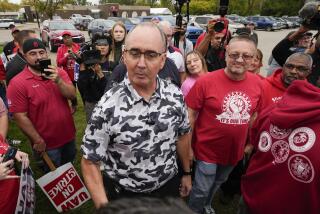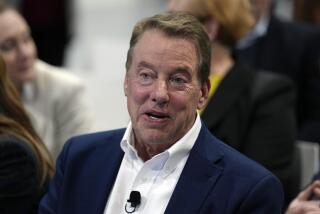Ford’s $5.8-billion loss caps its worst year ever
- Share via
Ford Motor Co. posted a fourth-quarter net loss Thursday of almost $5.8 billion, capping the worst year in the company’s 103-year history.
The 2006 loss of $12.75 billion highlighted the difficulty of reviving the nation’s No. 2 automaker, which hasn’t been in the black since the second quarter of 2005. Sales of pickup trucks and sport utility vehicles -- Ford’s most profitable products -- have slumped amid high gasoline prices, and the company is facing fierce competition from foreign automakers such as Toyota Motor Corp.
“As expected, Ford’s fourth-quarter and full-year results were ugly,” analyst Shelly Lombard of bond research firm Gimme Credit said in a research note. “Ford’s undergoing the corporate equivalent of major corrective surgery, so the company’s going to look worse before it gets better.”
Chief Executive Alan Mulally, lured from Boeing Co. in September to lead a turnaround at Dearborn, Mich.-based Ford, has cut jobs and closed plants, but losses are expected to continue at least through next year.
“We fully recognize our business reality and are dealing with it,” Mulally said Thursday. “We have a plan and we are on track to deliver.”
Investors initially appeared to be encouraged by Mulally’s reassurances, even though the quarterly loss of $1.10 a share from continuing operations was wider than the consensus Wall Street expectation of a loss of $1.01.
Ford’s stock jumped 4% after the earnings report but lost ground during the day amid a general market sell-off. Shares closed at $8.22, up 2 cents.
“The stock is trading on speculation that Mulally is the right guy for the job and that he will be able to mount some kind of comeback,” said John Novack, auto analyst at Morningstar Inc.
Ford is trying to reduce annual costs in its troubled North America auto operations by $5 billion by 2008. Under the plan, 16 plants will be closed, and 38,000 blue-collar workers have already accepted buyout offers. The company also is reducing its white-collar workforce by a third, or about 14,000 jobs.
Mulally said the company was considering reviving its bonus program for salaried employees “to make sure that we are paying competitive wages and benefits.”
The CEO said it would be “a couple of months” before a decision was made on the bonuses, which could be a tricky issue when the company begins contract talks in July with the United Auto Workers union.
“It’s very hard for someone to say, ‘I’m going to accept cuts to my benefits and pay’ when someone else is getting a bonus,” said Efraim Levy, auto analyst with Standard & Poor’s. “The inequity of it is going to rankle the rank and file.”
A spokesman for the UAW declined to comment.
Ford’s continued loss of market share in North America -- 15.1% at the end of December, compared with 16.7% at the end of 2005, according to Autodata Corp. -- is worrisome, Novack said. He noted that models Ford unveiled at the North American International Auto Show in Detroit this month were greeted tepidly by many analysts.
Worse, Toyota and General Motors Corp., the No. 1 automaker, are both aggressively marketing new pickup designs.
“They’re attacking Ford’s cash cow,” Novack said.
In a sign that market share declines could continue, Ford said it would cut vehicle production in North America even more than previously expected during the current quarter, producing 740,000 vehicles instead of 750,000. That compares with 876,000 vehicles in the first quarter of 2005.
Ford’s fourth-quarter loss of $3.05 a share widened from a loss of 4 cents a share in the last three months of 2005, when the company lost $74 million. Excluding one-time items -- mostly restructuring-related costs -- Ford lost $2.1 billion on continuing operations in the quarter, compared with a profit of $285 million a year earlier. Sales were down 13% to $40.3 billion.
Almost $10 billion of the full-year loss was attributed to costs associated with the restructuring. In 2005, the company posted a profit of $1.4 billion, or 77 cents a share. Full-year sales fell 9% in 2006 to $160.1 billion.
Previously, the company’s biggest annual loss was $7.39 billion in 1992.
*






